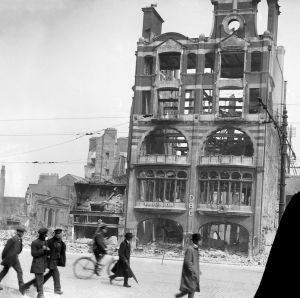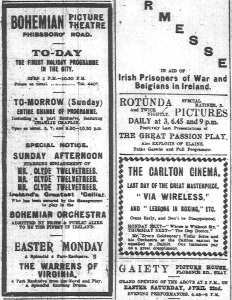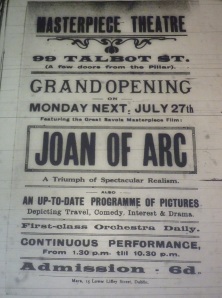
Among the Situations Wanted ads, a Waterville projectionist seeks new prospects; Irish Independent 1 Apr. 1916: 6.
Desiring a change of job, Edward McCabe, the operator (projectionist) at the cinema in Waterville, Co. Kerry, put a small ad in the Irish Independent outlining his five years of experience and seeking “good offers only.” McCabe was expectant – or at least hopeful – of an improved situation, and given cinema’s continuing growth despite the war, his prospects seemed good. Change was certainly coming to Ireland in April 1916, if not of the kind for which McCabe expressed a desire. Planned and executed by a small group of insurgent nationalists, socialists and women’s rights campaigners against British rule, the Easter Rising that month would be the catalyst for profound social and political change, but the cinema had few direct links with it. Although the Rising took place largely in Dublin between 24 and 29 April, the failure of the rebels to land arms in north Kerry – far from Waterville in the south – and the arrest of Rising leader Roger Casement as he was set ashore from a German U-Boat on 21 April influenced events in Dublin and elsewhere. When the Kerry events caused the planned Easter Sunday Rising to be initially cancelled and then rescheduled to Easter Monday, Frank Hardiman and his comrades in the Irish Volunteers and the secret Irish Republican Brotherhood in Galway were thrown into confusion. Manager of the Galway’s Town Hall Picture Palace for James T. Jameson’s Irish Animated Picture Company, Hardiman was arrested on Tuesday, 25 April, paraded with other rebels through the streets and imprisoned on a ship in Galway Bay (“Statement of Frank Hardiman”).

To the left of the iconic ruins of the DBC (Dublin Bread Company) on Dublin’s Lower Sackville/O’Connell Street in late April/early May 1916 were the ruins of the smaller Grand Cinema, its projection box visible on the first floor. Source: Irish Times.
The Rising was even more of a surprise than this for most people working in Irish cinema, and the few who became directly involved did so because they got caught up in events. Despite apparently having no direct role in the Rising, Irish-American diplomat James M. Sullivan, who had recently founded the Film Company of Ireland (FCOI), was arrested outside his home in Dublin on 28 April and imprisoned in Kilmainham Gaol until 6 May (“Irish-American Minister”). The FCOI’s offices at 16 Henry Street would be completely destroyed during the fighting of Easter Week, but the disruption and destruction that were the Rising’s most immediate effects on cinema in Dublin can be seem most clearly in the many photographs of the ruined Grand Cinema – the mangled remains of its projectors clearly visible – beside the iconic hulk of the Dublin Bread Company on Lower Sackville/O’Connell Street. The World’s Fair Waxworks at 30 Henry Street, one of the first and cheapest picture houses in the city, was also completely ruined. Other picture houses were also damaged, if not to this extent, and the military authorities who administered the city after the surrender of the rebels prohibited all entertainments for a time.
Cinema was prohibited as part of a general curfew rather than for any direct role in the Rising, but it did constitute revolutionary change of a kind in Ireland, bringing an explosion of imagery to people and places that could not have experienced anything like it before. This is perhaps epitomized by the Waterville Cinema that Edward McCabe desired to leave on the eve of the Rising. It opened in late December or early January 1916, when a rare notice appeared in the Kerryman commenting on the success of its opening (“New Cinema, Waterville”). It changed the films it showed four times a week, on Sunday, Monday, Wednesday and Friday, including such bill toppers as Chaplin’s The Property Man (US: Mutual, 1914), appropriate for a village that now hosts a Chaplin festival. That Waterville had a picture house at all is remarkable, given that the 1911 Census put its population at just 300 inhabitants and that the village itself was located on the extreme western periphery of Europe. It must have been a precarious enterprise, and it is extraordinary that it lasted even until McCabe sought to leave. The frequent changes suggest that the proprietor attempted to attract patrons several times a week in a region where many inhabitants were subsistence farmers or fisherfolk. Indeed, Ireland’s west coast held a special place in the nationalist consciousness because its remoteness made it a bastion of a tradition Irish culture that was often presented as an ascetic pastoralism conducted in the Irish language. If cinema could be in such a small, remote and traditional place, it seems it could be anywhere. However, Waterville and its environs had something that other poorer parts of the west did not. The peripherality of this part of Kerry had actually made it a hub of modernity, the site in the 1860s for the landing of the first transatlantic telegraphic cable and building of a telegraph station, located on nearby Valencia Island. News from America came first to this remote spot in south Kerry, and Waterville’s population included many who worked as relatively highly paid telegraphists. The patronage of these cable workers and their families who settled in the areas appears to have kept the cinema going at least until McCabe departed.

Announcement of the reopening of Skibbereen’s Kinemac as the Coliseum; Sikbbereen Eagle 22 Apr. 1916: 8.
Despite its unusual demographics, Waterville was by no means alone among remote locations in south Kerry and west Cork experiencing the new media of the 1910s, albeit that these changes were occurring in towns with much larger populations. Founded by vibrator entrepreneur Gerald Macaura in 1914, the troubled Kinemac in Skibbereen (pop. 3,021) reopened on 25 April 1916 under a new name, the Coliseum, managed by Andy Wright’s Southern Coliseums. Clonakilty, Co. Cork (pop. 2,961) also saw developments in its cinema enterprises, some of which were not entirely legal. On 23 March, 19-year-old Michael “Murt” O’Donovan was charged at a special court in the town with defrauding Alexander Bonthorne of Faulkland, Scotland and Malachy Brady of Tudor House, Roscommon by failing to supply home cinema equipment for which they had paid him (“Special Court”). O’Donovan had no link to Clonakilty’s picture house, which drew audiences from its hinterland. “‘Where are the boys of the village tonight?’” asked the columnist of the Southern Star’s “Shannonvale Notes.” “They are at the ‘Movies’ escorting certain young ladies and their lady friend who lives up [the] street. Since the Cinematograph started in Clon, it has been well patronised by the boys of our village.” Accompanying young ladies to the cinema was not looked on favourably by young men everywhere. When some of Clones, Co. Monaghan’s unmarried men founded a bachelors’ club to resist a mooted Bachelor Tax, they expressed their opposition to the practice of bringing local ladies “to picture houses, on excursions, picnics, motor drives, or cycle runs” (“Clones Bachelors”).
Even in such towns as Naas, Co. Kildare (pop. 3,842), which had only occasional picture shows, cinema could be encountered on a stroll. “I confess I knew very little of Charlie Chaplin until the other day,” the Kildare Observer’s “Items and Ideas” columnist revealed. “Several times have I heard references to him in a ditty chanted in chorus by small boys from the lanes of Naas as they paraded the suburban thoroughfares.” The columnist included the words, sung to the tune of the 1907 song “Red Wing”:
The moon shines bright on Charlie Chaplin,
His boots is crackin’, for want of blackin’,
And his khaki trousers need a mendin’
Before we send him
To the Dardanelles.
By April 1916, many involved in Irish cinema were resisting or embracing changes sought by the British government, which was increasingly finding cinema useful in various ways. Despite the industry’s strenuous lobbying against it, the government was undeterred in its determination to divert some of the money spent on entertainments into its much depleted war reserves; it set 15 May as the day on which the new Amusement Tax would be imposed on picture houses and theatres. There seemed little firm opposition to it outside the industry in Ireland, the Evening Herald arguing that no valid argument can be advanced against it” (“Where Ireland Goes Out”). Film’s increasingly direct role in recruiting in Ireland was highlighted when H. Higginson announced that he – like Edward McCabe – desired a change and was resigning the managership of the newly reopened Clontarf Cinema in Dublin to lead a cinema recruiting campaign. He proposed to give two shows in each place the campaign reached, the first exhibiting army and navy films, and the second offering a regular drama and comedy programme whose proceeds would go to various war funds. He also intended “to arrange so that the first man who is actually accepted and passed by the doctor for service with the colours will be presented free with a high-class solid silver luminous wristlet watch, the usual shop price of which is 43s” (“Cinema Recruiting Campaign”). No such recruiting event appears to have been reported later in April, but James J. Stafford’s lent his cinema for a “war meeting” in Longford on 14 April at which films showed “what the war means, in many phases, and the large gathering that thronged the Theatre were treated to a series of recruiting speeches which were generally acknowledged to be the strongest delivered since the start of the military canvass of the country” (“War Meeting in Longford”).
The long-running campaign for educational uses of film gained a new public advocate in mid-April 1916 when David Gilmore from Belfast’s Ormeau Road wrote a letter to the Belfast Newsletter outlining how the dangers of carelessly discarded fruit peel might be ameliorated cinematically. He suggested that “if each cinema show displayed a short film at each exhibition depicting the evil of throwing slippery things on the sidewalk, and a reading caution not to do so, thousands of children would take thought and not throw peel, &c., where people would slip on it.” His enthusiasm for this early public service film extended to an imagined scenario: “The little silent drama could show a child throwing peel down, a person slipping thereon, lying in a hospital, and then creeping about on crutches. Or the drama could end by a funeral, as slipping on orange peel has caused in more than one case” (“Throwing Orange Peel”). He may have been joking, but if not, he displayed a surprising unawareness that films already dealt extensively with casually or maliciously tossed peel, film comedians having done, if anything, too much to exploit the banana skin’s comic potential.

Cellists Clyde Twelvetrees and Joseph Schofield Source: Royal Irish Academy of Music blog.
The changes that picture houses had brought to Dublin’s entertainment world meant that they competed for audiences with popular theatres. By no means for the first or last time, this was explicit again in the week beginning 17 April 1916, when the Empire Theatre’s programme consisted not of its usual variety acts but of the film The Rosary (US: Selig, 1915), starring Kathlyn Williams. The film has been shown first in the city at the Theatre Royal over the 1916 New Year week and had had subsequent runs at the Princess Cinema in Rathmines (14-16 Feb.), the Phoenix Picture Palace on Ellis Quay (6-9 Apr.) and the Dame Street Picture House (13-15 Apr.). Despite the recent showings at the Phoenix and Dame, Empire manager Barney Armstrong must have considered this religious-themed film a good prospect in the run-up to Easter weekend because he offered additional musical attractions that would see the film accompanied “with organ and full orchestra effects” (“Empire Theatre”). When shown at the picture houses, the film had received little attention from newspaper critics, but when it appeared at the Empire, the main daily newspapers gave it as much critical attention as they gave to any other show. However, they gave it a mixed reception. Although the Evening Telegraph reviewer called The Rosary a “splendid” film – perhaps referring to its seven-reel length – s/he complained that it showed “a woeful ignorance of Irish Catholic sentiment, and the impersonations [offer] very little suggestion of an Irish atmosphere” (ibid).

The Bohemian advertised its engagement of Twelvetrees prominently in its Easter programme, beside the Carlton’s ad for its attractions, including Erwin Goldwater’s solo playing; Dublin Evening Mail 22 Apr 1916: 2.
The disparities in the press attention that the Rosary received at the picture houses and at the Empire were an indication that theatre remained the dominant entertainment medium, but there were also indications that this situation was changing. In attracting patrons to The Rosary, the Empire advertised the superiority of the musical attractions it could offer. However, several of the city’s picture houses were enhancing their musical offerings to compete against each other and the theatres. On St Patrick’s Day, 17 March 1916, concert violinist Erwin Goldwater had become resident soloist at the recently opened Carlton Cinema. This somewhat undermined the Bohemian Picture Theatre long advertised claim that it possessed the largest and best orchestra of any of the city’s picture houses. In response, the Bohemian engaged Clyde Twelvetrees – concert cellist and professor of the Royal Irish Academy of Music – to play as part of its daily programme. “Up to the present,” the Irish Independent commented, “if one wanted to hear a few famed soloists one had to attend the big concerts; but now one can hear the very best at convenience (“Dublin and District”). And these musical opportunities were set to increase, as Dublin’s Pillar Picture House engaged another renowned cellist, Joseph Schofield.
Schofield’s debut at the Pillar did not, however, take place as scheduled, at 4pm on Easter Monday, 24 April 1916. By that time, members of the Irish Volunteers and Irish Citizen Army under Patrick Pearse and James Connolly had taken possession of the nearby GPO, and the Rising was underway. Dublin’s cinema screens would remain dark for two weeks as more urgent changes took the stage.
References
“A Cinema Recruiting Campaign.” Dublin Evening Mail 6 Apr. 1916: 4.
“Clones Bachelors Establish a Washing, Cooking and Household Managing Club.” Anglo-Celt 1 Apr. 1916: 11.
“Clontarf Cinema Theatre to be Opened on Sundays.” Evening Telegraph 31 Mar. 1916: 3.
“Dublin and District.” Irish Independent 22 Apr. 1916: 4.
“The Empire Theatre.” Evening Telegraph 18 Apr. 1918: 6.
“Irish-American Minister: Unpleasant Experiences in Dublin.” Evening Herald 9 May 1916: 1.
“Items and Ideas.” Kildare Observer 1 Apr. 1916: 5.
“New Cinema, Waterville.” Kerryman 8 Jan. 1916: 8.
“Shannonvale Notes.” Southern Star 15 Apr. 1916: 1.
“Special Court in Clonakilty.” Skibbereen Eagle 1 Apr. 1916: 3.
“Statement of Frank Hardiman.” Bureau of Military History, Witness Statement 406, p. 2-3 <http://bureauofmilitaryhistory.ie/reels/bmh/BMH.WS0406.pdf#page=1>
“Throwing Orange Peel, &c., on Sidewalks.” Belfast Newsletter 12 Apr. 1916: 6.
“War Meeting in Longford.” Longford Leader 22 Apr. 1916: 1.
“War Pictures.” Longford Leader 15 Apr. 1916: 1.
“Where Ireland Goes Out.” Evening Herald 13 Apr. 1916: 2.






